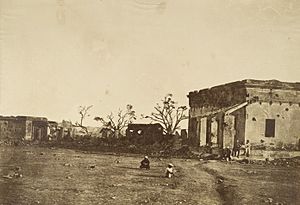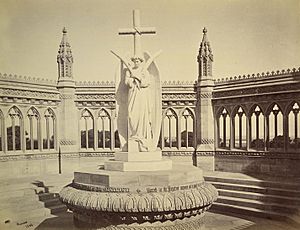Hugh Wheeler (East India Company officer) facts for kids
Quick facts for kids
Hugh Massy Wheeler
|
|
|---|---|

Hugh Massy Wheeler by Charles D'Oyly
|
|
| Born | 30 June 1789 County Tipperary, Ireland |
| Died | 27 June 1857 (aged 67) Cawnpore, India |
| Allegiance | |
| Service/ |
Bengal Army |
| Years of service | 1803–1857 |
| Rank | Major General |
| Battles/wars | First Anglo-Afghan War First Anglo-Sikh War Second Anglo-Sikh War Indian Rebellion of 1857 |
| Awards | Order of the Durrani Empire KCB |
Sir Hugh Massy Wheeler (born June 30, 1789) was an important officer in the army of the East India Company. He was born in Ireland and spent most of his life serving in India. He led troops in several major wars, including the First Anglo-Afghan War and the Anglo-Sikh Wars. In 1856, he became the commander of the army base in Cawnpore (now Kanpur). He is mostly remembered for the tragic events that happened there during the Indian Rebellion of 1857.
Contents
Early Life and Military Start
Hugh Massy Wheeler came from an Anglo-Irish family. This means his family had British roots but lived in Ireland for a long time. His father was also a captain in the East India Company. Hugh was born in County Tipperary, Ireland, on June 30, 1789.
He joined the Bengal Army as a cadet in 1803 when he was just 14. He arrived in India in 1805 and began his military career.
Rising Through the Ranks
Wheeler quickly moved up in the army. By 1819, he was a captain. He became a major in 1829 and a lieutenant-colonel in 1835. He married Frances Oliver (whose maiden name was Marsden). She was an Anglo-Indian woman, meaning she had both British and Indian heritage. They had several children together.
Wars and Achievements
Wheeler led his soldiers in the First Anglo-Afghan War from 1838 to 1839. His troops helped capture important cities like Ghazni and Kabul. After the war, he was honored for his bravery and skill. He received the Order of the Bath and the Order of the Dooranee Empire.
During this time, his son Frank, who was also a soldier, was killed in Afghanistan. Frances Oliver's first husband, Thomas Oliver, also died defending Kabul. Frances and Hugh Wheeler then married in 1842.
Leading in the Sikh Wars
Wheeler continued to serve with distinction in the First Anglo-Sikh War (1845-1846). He was wounded in one battle but still fought bravely. He was made an honorary aide-de-camp to Queen Victoria.
He also played a key role in the Second Anglo-Sikh War (1848-1849). His actions earned him praise from the governor-general. Both the British Parliament and the House of Lords thanked him. In 1850, he was made a Knight Commander of the Order of the Bath (KCB). This was a very high honor.
After these wars, he was promoted to major-general in 1854. He took a short break to visit Ireland. In 1856, he returned to India for his final command in Cawnpore.
Life in Cawnpore
By the time Wheeler arrived in Cawnpore, he was 67 years old. He had spent about 50 years serving in India. People described him as a small, thin man with a sharp mind. He spoke Hindi very well and was well-liked by the Indian soldiers, known as sepoys.
Cawnpore was an important town on the River Ganges. It was a large military base and also a busy trading center. Many British families lived there, and it had become like a small English town. It was connected to Calcutta by telegraph and steam boats.
The Local Leader, Nana Sahib
North of Cawnpore was a town called Bithoor. An Indian leader named Nana Sahib lived there. He was the adopted son of a former ruler. Nana Sahib was generally friendly with the British. He often invited British officers and civilians to his home. However, he had a disagreement with the British government about his pension.
The 1857 Rebellion Begins
In May 1857, a major rebellion broke out in India. It started in Meerut, near Delhi. News of the rebellion quickly spread. In Cawnpore, there were about 3,000 Indian soldiers and only about 300 British soldiers.
Wheeler tried to keep the peace in Cawnpore. He sent daily messages to the governor-general, saying things were calm. But he also prepared for trouble. He ordered a barracks building to be fortified. This was meant to be a safe place for the European, Eurasian, and Christian Indian people in the town.
Some people later criticized Wheeler for choosing this spot. They thought a stronger fort further away would have been better. But Wheeler likely hoped his soldiers would stay loyal. He also didn't expect the rebellious troops to stay in Cawnpore.
On June 5, some Indian soldiers in Cawnpore rebelled. They left their barracks but did not harm their officers. The next morning, most of the other Indian regiments joined them. Some loyal sepoys, however, stayed with Wheeler.
The Siege of Cawnpore
At first, the rebellious soldiers headed towards Delhi. But on June 6, they returned to Cawnpore. Nana Sahib was now leading them. He sent a message to Wheeler, saying he would attack. Soon after, his forces began firing on Wheeler's fortified area.
Wheeler's fort, called the entrenchment, had two large barracks buildings. One was used as a hospital. A low wall of earth was quickly built around them. About 1,000 people were inside, but only 300 were soldiers. The rest were civilians, mostly women and children.
Life inside the entrenchment was very hard. Food was scarce, and getting water was dangerous because the only well was exposed to enemy fire. Guns were also in short supply. The hospital building burned down after being hit. Many people suffered from disease and the intense heat. General Wheeler's son, Godfrey, was killed during the siege.
Despite these terrible conditions, the entrenchment held out for three weeks. The defenders fought off several attacks. Captain John Moore took a very active role in leading the defense. Wheeler, being older, was not able to be out in the open as much.
Wheeler sent a message asking for help from Lucknow. He wrote, "The whole Christian population is with us... our defense has been noble and wonderful... We want aid, aid, aid..." However, help could not reach them because the rebels controlled the river.
A Tragic End
On June 25, after nearly three weeks of fighting, Nana Sahib offered a deal. He promised safe passage to Allahabad if Wheeler's group surrendered. Wheeler accepted the offer.
On the morning of June 27, Wheeler and the survivors walked to the River Ganges. Boats were waiting for them at a place called Satichaura Ghat. The British were allowed to keep their small weapons. However, as they were getting into the boats, firing broke out.
General Wheeler, his wife, and his elder daughter were among those killed in the attack. Some survivors were captured. The women and children who survived were later killed on July 16, as British forces approached Cawnpore. It is still debated whether Nana Sahib planned this attack. Only a few British soldiers managed to escape. It is believed that Wheeler's younger daughter, Margaret, survived and was taken away by an Indian soldier.
Wheeler's Family
Hugh and Frances Wheeler had nine children together. Seven were born before they married, and two after. Many of their sons followed their father into the army. Four of them, George, Frederick, Patrick, and Robert, became generals.
Wheeler also had another son, Francis, from an earlier relationship. Frances Matilda's mother was Indian.
The memorial tablets in All Souls Church, Kanpur, remember those who died. It lists "Sir H. Wheeler, K. C. B.; Lady Wheeler and daughters; Lieutenant G. R. Wheeler, 1st N. I., A.-D.-C;". This shows that his wife, his son Godfrey, and his elder daughter Eliza died with him.
Images for kids






